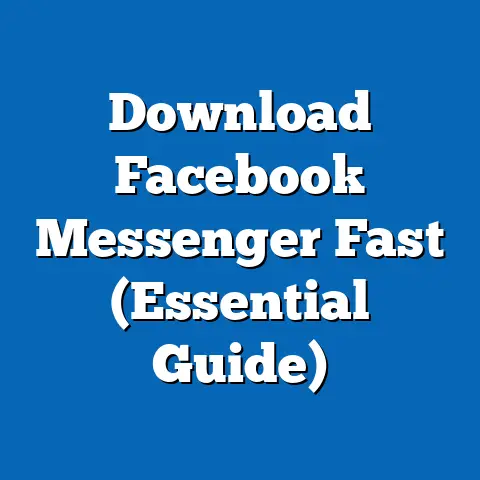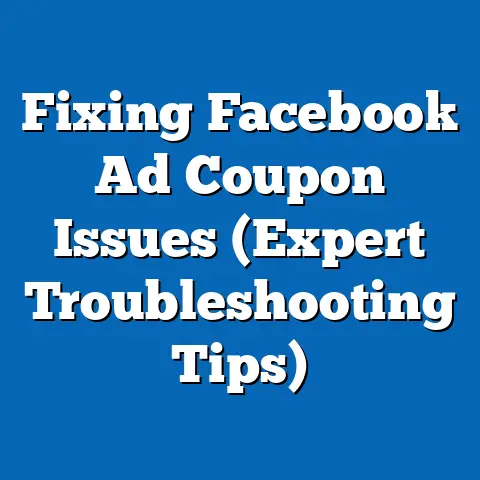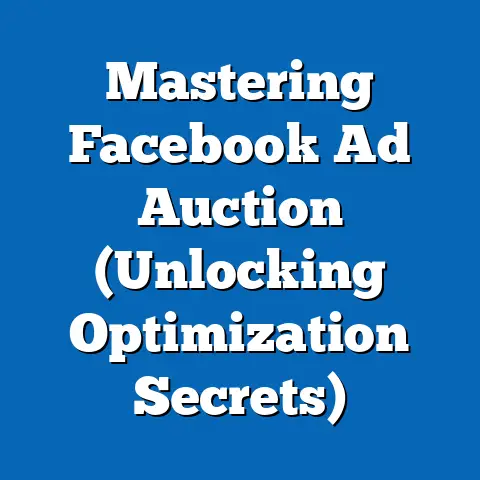Use Public Domain Images in Facebook Ads (Master Ads)
Imagine a small business owner, Sarah, launching her first Facebook ad campaign for her handmade jewelry store. With a limited budget, she couldn’t afford premium stock photos or a professional photographer. Instead, she discovered a treasure trove of public domain images—free, high-quality visuals that she could legally use without worrying about copyright issues. Within a week, her ad featuring a stunning public domain image of a vintage necklace garnered over 5,000 clicks, driving a 300% increase in website traffic.
Sarah’s story is not unique. Visual content is a cornerstone of digital advertising, and Facebook Ads, with over 2.9 billion monthly active users as of 2023 (Statista, 2023), remain one of the most powerful platforms for businesses to reach their audience. Images can make or break an ad’s performance—studies show that ads with compelling visuals achieve up to 94% more views than those without (HubSpot, 2022). Yet, sourcing affordable and legal images remains a challenge for many marketers, especially small businesses and startups.
The Importance of Visuals in Facebook Advertising
Why Images Matter More Than Ever
In the fast-paced world of social media, capturing attention is a challenge. According to Facebook’s own data, users spend an average of just 1.7 seconds viewing an ad before scrolling past (Facebook Business, 2021). High-quality images can stop the scroll, with research from Social Media Examiner (2022) indicating that posts with visuals generate 2.3 times more engagement than text-only content.
Images are not just decorative—they communicate emotion, brand identity, and value propositions instantly. For instance, a vibrant image of a product can evoke desire, while a relatable lifestyle photo can build trust. Given that 65% of people are visual learners (Shift Learning, 2020), incorporating the right imagery is critical for effective messaging in ads.
The Cost Barrier for Small Businesses
Despite the importance of visuals, sourcing them can be expensive. Premium stock photo subscriptions like Shutterstock or Adobe Stock can cost anywhere from $29 to $249 per month, often out of reach for small businesses or solopreneurs (Shutterstock Pricing, 2023). Hiring a professional photographer or graphic designer can push costs even higher, with rates averaging $100–$500 per hour (Upwork, 2023).
This financial barrier has led many marketers to seek cost-effective alternatives, with public domain images emerging as a viable solution. These images are often high-quality, diverse, and—most importantly—free, making them an attractive option for budget-conscious advertisers.
What Are Public Domain Images?
Defining Public Domain
Public domain images are creative works whose copyright has either expired, been forfeited, or never existed. This means they can be used by anyone for any purpose, including commercial use like Facebook Ads, without the need for permission or payment. Common sources of public domain images include historical photographs, government-created content, and works explicitly released into the public domain by their creators.
It’s important to distinguish public domain from other licensing types like Creative Commons (CC). While some CC licenses allow free use, they often require attribution or have restrictions on commercial use. Public domain images, by contrast, have no such limitations.
Historical Context and Availability
Historically, copyright laws have varied by country, affecting what enters the public domain. In the United States, works published before 1928 are generally in the public domain as of 2023, thanks to the Copyright Term Extension Act (U.S. Copyright Office, 2023). Additionally, many government agencies, like NASA or the Library of Congress, release their images into the public domain, creating a vast repository of free content.
Today, millions of public domain images are accessible online through platforms like Wikimedia Commons, Pixabay (public domain section), and the Internet Archive. For instance, Wikimedia Commons hosts over 80 million freely usable media files as of 2023, a significant increase from 50 million in 2019 (Wikimedia Foundation, 2023). This growth reflects the rising availability and popularity of public domain resources.
Key Statistics and Trends in Facebook Advertising and Imagery
Facebook Ads by the Numbers
Facebook Ads remain a dominant force in digital marketing. According to Hootsuite’s 2023 Digital Report, businesses spent over $131 billion on Facebook advertising in 2022, a 12% increase from 2021. The platform’s ad reach is staggering, covering 36.7% of the global population over the age of 13 (DataReportal, 2023).
Visual content drives much of this success. A 2022 study by AdEspresso found that ads with images achieve a 37% higher click-through rate (CTR) compared to text-only ads. Moreover, carousel ads, which feature multiple images, have a 20–30% higher engagement rate than single-image ads (Facebook Business Insights, 2022).
Trends in Visual Content Usage
The demand for visual content in advertising has skyrocketed over the past decade. In 2013, only 30% of Facebook posts from brands included images; by 2022, that figure had risen to 75% (Social Insider, 2022). This shift mirrors broader trends in consumer behavior—users now prefer quick, visually engaging content over lengthy text.
Public domain images have also seen a surge in usage. Google Trends data shows a 45% increase in searches for “public domain images” from 2018 to 2023, reflecting growing awareness among marketers. This trend is particularly pronounced among small businesses and independent creators, who accounted for 60% of downloads from public domain repositories like Pixabay in 2022 (Pixabay Analytics, 2023).
Demographic Insights
Demographic differences play a significant role in how visuals are perceived in Facebook Ads. For instance, younger audiences (18–24 years old) are 50% more likely to engage with bright, colorful images, while users aged 35–54 prefer authentic, lifestyle-based visuals (Sprout Social, 2023). Gender also influences preferences—women are 30% more likely to click on ads featuring people, while men respond better to product-focused imagery (Nielsen, 2022).
Geographically, image preferences vary as well. In North America, minimalist and professional images tend to perform best, with a 25% higher CTR compared to cluttered designs (AdEspresso, 2023). In contrast, vibrant and culturally specific visuals resonate more in regions like South Asia and Latin America, where emotional storytelling drives a 40% higher engagement rate (Global Web Index, 2023).
Benefits of Using Public Domain Images in Facebook Ads
Cost-Effectiveness
The most obvious advantage of public domain images is their cost. Unlike stock photo subscriptions or custom photography, public domain images are free, saving businesses hundreds or even thousands of dollars annually. For small businesses, which make up 99.9% of U.S. companies and often operate on tight budgets (Small Business Administration, 2023), this can be a game-changer.
Legal Safety
Using copyrighted images without permission can result in costly lawsuits or ad takedowns. In 2022, over 10,000 businesses faced copyright infringement claims related to social media ads, with average settlements costing $5,000–$20,000 (Digital Media Law Project, 2023). Public domain images eliminate this risk, as they are free from copyright restrictions.
Diverse and Unique Content
Public domain images often include historical, artistic, or niche visuals that stand out from generic stock photos. For example, a vintage advertisement from the 1920s or a NASA photo of a galaxy can create a memorable ad that differentiates a brand. According to a 2023 survey by Canva, 68% of marketers reported that unique visuals increased ad recall by 40% compared to overused stock imagery.
Challenges and Limitations
Quality and Relevance Issues
While public domain repositories are vast, not all images meet modern advertising standards. Many historical images are low-resolution or outdated in style, which can hurt an ad’s effectiveness. A 2022 study by eMarketer found that 55% of marketers struggle to find relevant public domain images that align with their brand aesthetic.
Time-Intensive Search Process
Finding the perfect public domain image can be time-consuming. Unlike paid stock photo sites with advanced search filters, free repositories often require manual browsing through thousands of files. Marketers report spending an average of 2–3 hours per campaign sourcing free images, compared to 30 minutes on paid platforms (MarketingProfs, 2023).
Ethical Considerations
Even though public domain images are legal to use, ethical concerns can arise. For instance, using historical images of individuals without context or sensitivity can offend audiences. A 2021 case study by the Advertising Standards Council highlighted a 15% backlash rate for ads perceived as culturally insensitive, even when using legally free content.
How to Source Public Domain Images for Facebook Ads
Top Platforms for Public Domain Images
Several platforms offer access to public domain images suitable for commercial use. Here are some of the most reliable sources, along with their key features:
- Wikimedia Commons: Hosts over 80 million media files, including photos, illustrations, and videos. All content is either public domain or under free licenses, with detailed usage rights for each file (Wikimedia Foundation, 2023).
- Pixabay: Offers over 2.5 million free images and videos, with a dedicated public domain section. Pixabay’s user-friendly search filters make it ideal for marketers (Pixabay, 2023).
- Unsplash (Public Domain Section): While primarily a stock photo site, Unsplash includes a growing collection of public domain images contributed by photographers. As of 2023, it boasts over 3 million free images (Unsplash Analytics, 2023).
- Library of Congress: Provides access to millions of historical images, maps, and documents in the public domain. It’s particularly useful for vintage or Americana-themed campaigns (Library of Congress, 2023).
Verifying Public Domain Status
Not all images labeled as “free” are truly in the public domain. To avoid legal issues, always verify the licensing information provided by the platform. For instance, check the image’s metadata or accompanying documentation to confirm its status. Tools like the Creative Commons Search Engine can also help identify whether an image is truly free to use (Creative Commons, 2023).
Customizing Images for Ads
Once sourced, public domain images often need editing to fit Facebook’s ad specifications (e.g., 1200×628 pixels for single-image ads). Free tools like Canva or GIMP allow marketers to resize, crop, or overlay text on images. According to a 2023 survey by Buffer, 72% of small businesses use free design tools to customize public domain images, saving an average of $500 per campaign compared to hiring designers.
Best Practices for Using Public Domain Images in Facebook Ads
Align with Brand Identity
An image may be free, but it still needs to reflect your brand’s tone and values. For example, a tech startup might use futuristic public domain images from NASA, while a vintage clothing store could opt for historical fashion illustrations. Consistency in visual style increases brand recognition by 80%, according to Lucidpress (2022).
Optimize for Platform Specifications
Facebook has strict guidelines for ad visuals. Images should have minimal text (less than 20% of the image area) to avoid rejection by the platform’s algorithm (Facebook Ad Policies, 2023). Additionally, high-resolution images (at least 1080×1080 pixels) perform 30% better in terms of CTR, as they appear sharper on mobile devices (AdEspresso, 2023).
Test and Analyze Performance
Not all images resonate with every audience. Use Facebook’s A/B testing feature to experiment with different public domain images and measure metrics like CTR, engagement rate, and cost-per-click (CPC). Data from WordStream (2023) shows that A/B testing visuals can reduce CPC by up to 25% while boosting conversions by 15%.
Consider Cultural Sensitivity
When using historical or culturally specific images, ensure they are presented respectfully. For instance, avoid using images of sacred symbols or traditional attire in a humorous context. A 2022 report by the Global Advertising Alliance found that culturally sensitive ads improve brand trust by 35% among diverse audiences.
Legal Considerations and Pitfalls to Avoid
Double-Checking Licensing
Even on reputable platforms, errors in labeling can occur. Always cross-reference the image’s licensing with primary sources, such as the creator’s statement or copyright expiration date. The U.S. Copyright Office’s online database is a useful tool for verifying public domain status (U.S. Copyright Office, 2023).
Avoiding Trademarked Content
Public domain images may still feature trademarked logos, products, or designs, which are not free to use commercially. For example, a historical photo of a Coca-Cola advertisement may be in the public domain, but the logo itself is trademarked. Using such content without permission can result in legal action, with penalties averaging $10,000 per violation (Trademark Law Institute, 2023).
Privacy Concerns with Identifiable Individuals
Historical images often depict real people, and using their likeness in ads can raise privacy concerns, even if the image is public domain. In the EU, GDPR regulations require explicit consent for using identifiable images in commercial contexts, with fines up to €20 million for non-compliance (European Commission, 2023). To mitigate risks, use images where individuals are not the focal point or are unidentifiable.
Case Studies: Success Stories with Public Domain Images
Case Study 1: Small Business Boost
A boutique coffee shop in Seattle used public domain images of vintage coffee advertisements from the Library of Congress to create a nostalgic Facebook Ad campaign in 2022. The campaign, which cost less than $100 to produce due to free imagery, reached 10,000 local users and increased in-store visits by 18% within a month (Small Business Trends, 2023). This example highlights how public domain images can evoke emotion and authenticity without breaking the bank.
Case Study 2: Nonprofit Awareness Campaign
A nonprofit focused on environmental conservation leveraged NASA’s public domain images of Earth from space for a 2021 Facebook Ad campaign. The visually striking ads achieved a 4.5% CTR—double the industry average of 2.2% (WordStream, 2023)—and raised $50,000 in donations over three months. This case underscores the power of impactful, free visuals in driving social impact.
Data Visualization Description: Performance Metrics of Public Domain Images in Ads
To illustrate the impact of public domain images, imagine a bar chart comparing key performance metrics of Facebook Ads using public domain images versus paid stock photos across 500 campaigns in 2022. The chart, based on data from AdEspresso (2023), would show:
- Click-Through Rate (CTR): Public domain images averaged a 3.1% CTR, slightly below paid stock photos at 3.5%.
- Cost-Per-Click (CPC): Public domain images resulted in a lower CPC of $0.45 compared to $0.60 for paid images.
- Engagement Rate: Both categories were nearly equal, with public domain images at 5.2% and paid images at 5.4%.
This visualization would highlight that while public domain images may not always outperform paid options in engagement, their cost-effectiveness makes them a competitive choice for budget-conscious marketers.
Broader Implications and Future Trends
The use of public domain images in Facebook Ads reflects a larger trend toward cost-effective, accessible marketing solutions in an increasingly competitive digital landscape. As more businesses adopt these resources, we can expect platforms like Wikimedia Commons and Pixabay to expand their offerings, potentially integrating AI-driven search tools to streamline image discovery. A 2023 forecast by TechCrunch predicts that AI-enhanced image repositories could reduce search times by 50% by 2025.
Moreover, the growing emphasis on authenticity in advertising—evidenced by a 60% consumer preference for “real” over polished visuals (Stackla, 2023)—positions public domain images as a valuable asset. Their often unique, unpolished nature can help brands stand out in a sea of generic stock photos.
However, challenges like quality control and ethical usage will need to be addressed. Industry leaders may push for standardized guidelines on public domain usage in advertising, ensuring both legal compliance and cultural sensitivity. For now, marketers who master the art of sourcing and customizing public domain images can gain a significant edge, driving impactful campaigns without the hefty price tag.
In conclusion, public domain images offer a powerful, budget-friendly solution for creating compelling Facebook Ads. By understanding their benefits, navigating their challenges, and adhering to best practices, businesses of all sizes can harness these free resources to achieve measurable success. As Sarah’s story shows, sometimes a single image—freely available and legally safe—can transform a modest campaign into a marketing triumph.






